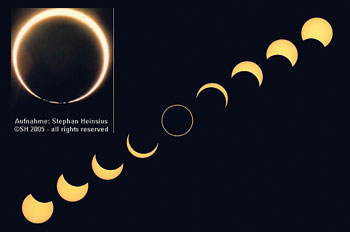Eclipses have fascinated and frightened humans through recorded history. The oldest solar eclipse observation is a Chinese record dated 709 BC. In the modern age when the Internet and TV can bring events to your home, you may wonder why some eclipse-chasers travel round the world to see an Eclipse of the Sun. But a solar eclipse is an event which must be observed. No video shown on TV can do justice to this inspiring spectacle of nature.
The last solar eclipse to cross Lanka was on June 20, 1955. It was a total eclipse and drew the largest number of professional astronomers to the country. Unfortunately, most of these teams were in the Polonnaruwa district that was clouded out. Limited observations were done from Sigiriya, and by amateurs from Kalkudah on the East coast.
 |
| Bailey’s Beads |
The next partial eclipse in Sri Lanka begins a few minutes after 11.13 a.m. and ends before 3:12 p.m. on Friday, January 15. The centre-line passes through the Jaffna peninsula. The Moon will be seen in front of the Sun, leaving 15.6% of the Sun still visible as a bright ring. The annular phase will have the longest duration of over 10 minutes from about 1.20 to 1.30 p.m at an altitude of 55 degrees. This maximum phase will be around this time within a few minutes for all parts of Lanka.
The southern border of the annular path crosses just north of Chilaw on the west coast and north of Nilavali on the east coast.
The border crosses south of Anuradhapura, just north of Eppawala. North of this border and far from the centre-line the ring will appear non symmetrical with one side much thinner. About a kilometre just north of the southern border, although the annularity will be very short, the Moon will graze the edge of the Sun, and one would observe interesting phenomena such a Bailey's beads not seen further in towards the centre-line. From south of this border we see only a partial eclipse. For example from Colombo, the Sun will be visible like a thin crescent.
The weather can always be a spoiler in watching any astronomical event. But as long as you can see the Sun you get a good view of an annular eclipse. Unlike in a total solar eclipse which requires it to be perfectly clear to see the corona, that in any case is not seen in an annular. Over the 600-year period from 1500 to 2100 AD, it has been computed that three total solar eclipses and 11 annular solar eclipse paths crossed Lanka. However since the path is narrower than the island, from any one location in Lanka, there was only one total and 4 or 5 annular eclipses of the Sun.
So this annular solar eclipse of January 15 which is visible in Northern Lanka, is a rare opportunity for Lankans. Although not as spectacular as a total eclipse, it is worth the travel to watch, particularly since the A9 is now open without restriction and there is also a lot more to see in the North.
Astronomers are hoping the weather will be favourable for this eclipse. The eclipse will be streaming live from Jaffna on the Internet via http://eclipse.skylk.com.
The stream will be open throughout the eclipse. For more information visit http://lakdiva.org/eclipse2010/
How to observe a solar eclipse
It is never safe to look at the Sun, without the proper equipment and techniques. Even when 85% of the Sun's surface is obscured during the annular phases of this solar eclipse, the remaining crescent Sun is still intense enough to cause permanent retinal damage, especially when viewed through binoculars or other optical aids.
Unfiltered digital cameras will get destroyed. One can use electric welder’s glass available at many local hardware shops for under Rs. 60 as a filter. The recommended shade 14 is not available in Lanka, but Shade 12 or 13 are OK.
Although not as good as proper filters, the packaging used for milk powder can also be used since it is designed to keep out harmful UV light. The Highland brand has a white inner surface and you don't see a reflection. These filters are opaque, other than when looking at the Sun, so if you can see anything else through them, it doesn’t have a good filter.
If used with an optical instrument such as a telescope or binoculars, the filtering MUST be at the objective BEFORE light enters the instrument. Make sure you don't leave any pin holes. |
